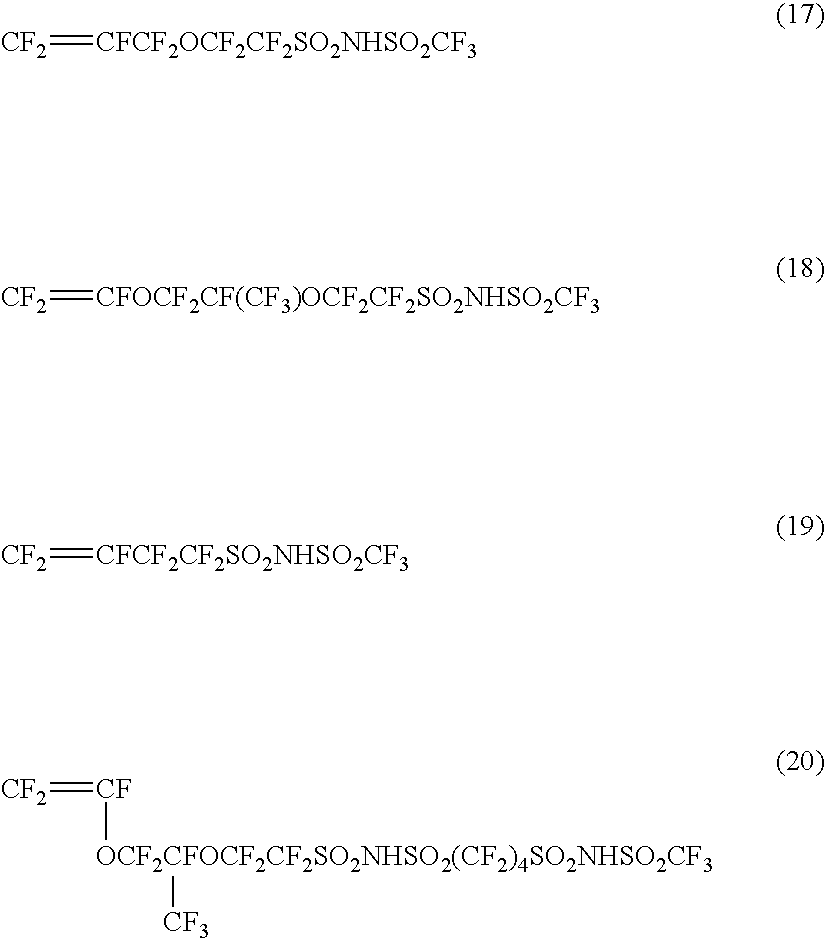Vinyl monomer with superacid ester group and polymer of the same
a technology of ester group and vinyl monomer, which is applied in the field of vinyl monomer with superacid ester group and polymer of the same, can solve the problems of oxidation resistance, low yield of the monomer represented by the aforementioned formula (16) (p=0), and difficulty in handling, and achieves high ion exchange group density, high yield, and easy production
- Summary
- Abstract
- Description
- Claims
- Application Information
AI Technical Summary
Benefits of technology
Problems solved by technology
Method used
Image
Examples
example 1
[0144] 45.0 g of CF2═CFOCF2CF2SO3Na synthesized according to the process described in International Unexamined Patent Publication No. 98 / 43952 were mixed with 63 ml of concentrated sulfuric acid followed by vacuum distillation (boiling point: 90° C. to 130° C. / 0.13 kPa) to obtain 15.6 g of a colorless liquid. This liquid was confirmed to be CF2═CFOCF2CF2SO3H by 19F-NMR and 1H-NMR (yield: 30%, purity: 80%).
[0145]19F-NMR: δ (ppm, CFCl3 standard) −137.7 (dd,1F), —124.2(dd,1F), −118.9 (s,2F), −116.8 (dd,1F), −86.0 ppm (s,2F) 1H-NMR: δ (Me4Si standard) 10.5 (s,1H)
[0146] 15 g of CF2═CFOCF2CF2SO3H were placed in a stainless steel 100 ml pressure-proof vessel and pressurized at 0.5 MPa with vinylidene fluoride. Vinylidene fluoride was suitably added and pressurized so as to maintain the internal pressure at 0.5 MPa while stirring at 100° C. After allowing the mixture to react for 5 hours, the pressure was released to obtain 18.8 g of an oily substance. This oily substance was confirmed to...
example 2
[0150] 0.2 g of the sulfonic acid ester polymer obtained in Example 1 were hot pressed after preheating for 10 minutes at 200° C. in a hot press to obtain a membrane having a thickness of 45 μm. When the IR spectrum of the resulting membrane was measured, the absorbance of the ester groups had completely disappeared and the absorbance of the sulfonic acid groups (970, 1059 cm−1) was confirmed to have appeared. In addition, the exchange group capacity, as measured by titration, was 920 g / eq in terms of the equivalent weight.
example 3
[0151] 0.5 g of the sulfonic acid ester polymer obtained in Example 1 were added to 20 ml of methanol and refluxed while heating for 2 hours. After drying off the solvent, the product was vacuum-dried at 50° C. to obtain a dry polymer. When the IR spectrum of the resulting solid was measured, the absorbance of the ester groups had completely disappeared and absorbance of sulfonic acid groups (970, 1058 cm−1) was confirmed to have appeared. In addition, when the exchange group capacity of this polymer was measured by titration, it was found to be 900 g / eq in terms of the equivalent weight.
[0152] Next, 0.4 g of the aforementioned fluorinated sulfonic acid polymer and 7.6 g of a water-ethanol mixed solution (1 / 1 by weight) were charged into a 100 ml pressure-proof vessel equipped with an inner glass cylinder, and stirred while heating for 4 hours at 180° C. After cooling to room temperature, the solid had completely disappeared and the contents of the vessel were in the form of a homo...
PUM
| Property | Measurement | Unit |
|---|---|---|
| Temperature | aaaaa | aaaaa |
| Temperature | aaaaa | aaaaa |
| Temperature | aaaaa | aaaaa |
Abstract
Description
Claims
Application Information
 Login to View More
Login to View More - R&D
- Intellectual Property
- Life Sciences
- Materials
- Tech Scout
- Unparalleled Data Quality
- Higher Quality Content
- 60% Fewer Hallucinations
Browse by: Latest US Patents, China's latest patents, Technical Efficacy Thesaurus, Application Domain, Technology Topic, Popular Technical Reports.
© 2025 PatSnap. All rights reserved.Legal|Privacy policy|Modern Slavery Act Transparency Statement|Sitemap|About US| Contact US: help@patsnap.com



